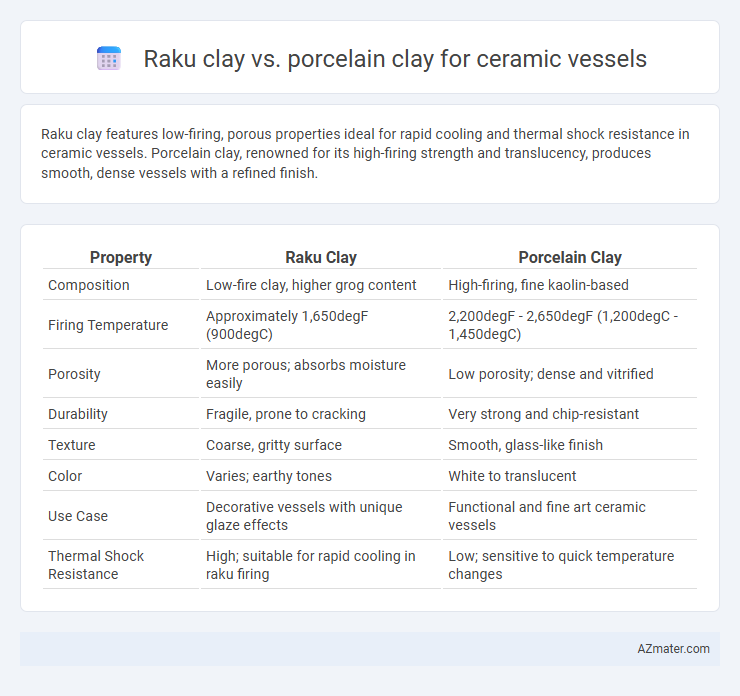Raku clay features low-firing, porous properties ideal for rapid cooling and thermal shock resistance in ceramic vessels. Porcelain clay, renowned for its high-firing strength and translucency, produces smooth, dense vessels with a refined finish.
Table of Comparison
| Property | Raku Clay | Porcelain Clay |
|---|---|---|
| Composition | Low-fire clay, higher grog content | High-firing, fine kaolin-based |
| Firing Temperature | Approximately 1,650degF (900degC) | 2,200degF - 2,650degF (1,200degC - 1,450degC) |
| Porosity | More porous; absorbs moisture easily | Low porosity; dense and vitrified |
| Durability | Fragile, prone to cracking | Very strong and chip-resistant |
| Texture | Coarse, gritty surface | Smooth, glass-like finish |
| Color | Varies; earthy tones | White to translucent |
| Use Case | Decorative vessels with unique glaze effects | Functional and fine art ceramic vessels |
| Thermal Shock Resistance | High; suitable for rapid cooling in raku firing | Low; sensitive to quick temperature changes |
Introduction to Raku Clay and Porcelain Clay
Raku clay is a low-fire, porous ceramic material known for its rapid cooling process and distinctive crackled glaze effects, often used in traditional Japanese pottery techniques. Porcelain clay, a high-fire, fine-grained material, offers superior strength, translucency, and a smooth, white surface ideal for delicate, refined ceramic vessels. Selecting between Raku and porcelain depends on desired aesthetics, firing temperature, and vessel functionality.
Historical Background of Raku and Porcelain
Raku clay originated in 16th-century Japan, developed for tea ceremony vessels emphasizing rapid firing and unique glaze effects achieved through thermal shock and reduction firing. Porcelain clay, dating back to the Tang Dynasty in 7th-century China, is prized for its high kaolin content, fine particle size, and vitrification at high temperatures, resulting in translucent, durable ceramic vessels. Both clays reflect distinct historical and cultural practices: Raku's organic, unpredictable aesthetics contrast with porcelain's refined, delicate craftsmanship.
Composition and Physical Properties
Raku clay typically contains a higher percentage of grog and fire clay, enhancing thermal shock resistance, which makes it suitable for the rapid cooling process of raku firing. Porcelain clay is composed mainly of kaolin, feldspar, and silica, producing a fine, white, and translucent body with high vitrification and strength after firing. Physically, porcelain exhibits higher density and low porosity compared to the porous and more fragile texture of raku clay vessels.
Workability and Handling Differences
Raku clay offers greater workability due to its lower firing temperature and higher plasticity, which makes shaping and molding easier compared to porcelain clay. Porcelain clay, being denser and finer, requires more precise handling as it is less forgiving during the forming process and can be prone to cracking. The porous nature of raku clay allows for faster drying and firing cycles, while porcelain demands slower drying to avoid structural damage.
Firing Processes: Raku vs. Porcelain
Raku clay undergoes a rapid firing process typically between 1,650degF to 1,830degF, followed by a quick reduction cooling phase outside the kiln, which imparts unique crackle effects and metallic finishes. Porcelain clay requires a much higher firing temperature, generally around 2,300degF to 2,650degF, during a slow, controlled firing that ensures vitrification and a dense, translucent final product. The contrasting firing processes significantly influence the surface texture, durability, and aesthetic qualities of ceramic vessels made from these clays.
Aesthetic Outcomes and Surface Finishes
Raku clay produces uniquely textured surfaces with crackled glaze effects and smoky, unpredictable patterns ideal for rustic and organic aesthetics. Porcelain clay offers smooth, translucent finishes with a refined, glass-like surface perfect for elegant, highly detailed ceramic vessels. The choice between Raku and Porcelain clays significantly impacts the visual appeal and tactile qualities of the final ceramic artwork.
Durability and Functional Strength
Raku clay, characterized by its lower firing temperature and porous nature, offers moderate durability but is more prone to chipping and thermal shock compared to porcelain clay. Porcelain clay, fired at higher temperatures around 1200-1400degC, yields a vitrified, dense body with superior functional strength ideal for everyday use in ceramic vessels. The enhanced durability of porcelain clay makes it resistant to moisture absorption and mechanical stress, ensuring longevity and consistent performance in functional ceramic ware.
Artistic Applications and Suitability
Raku clay offers enhanced thermal shock resistance and a porous texture, making it ideal for artistic applications involving rapid cooling and unique glaze effects in ceramic vessels. Porcelain clay, characterized by its fine particle size and high firing temperature, provides a smooth, translucent finish suitable for detailed and delicate artwork with a focus on elegance and durability. Artists favor raku for experimental, organic aesthetics, while porcelain is preferred for precise, refined, and functional ceramic pieces.
Cost and Accessibility Factors
Raku clay is generally more affordable and widely accessible compared to porcelain clay, making it suitable for artists on a budget or those new to ceramics. Porcelain clay, known for its purity and fine texture, tends to be more expensive due to the intensive refining process and higher-quality raw materials required. Accessibility to porcelain clay can be limited by specialty suppliers, while raku clay is commonly available through local art stores and workshops.
Choosing the Right Clay for Ceramic Vessels
Raku clay offers high thermal shock resistance and is ideal for pit firing techniques, producing unique texture and crackle effects suited for decorative vessels. Porcelain clay features a fine particle size, high plasticity, and smooth finish, making it perfect for delicate, thin-walled vessels requiring translucency and strength. Selecting between Raku and porcelain depends on the desired firing process, surface finish, and functional requirements of the ceramic vessel.

Infographic: Raku clay vs Porcelain clay for Ceramic vessel
 azmater.com
azmater.com